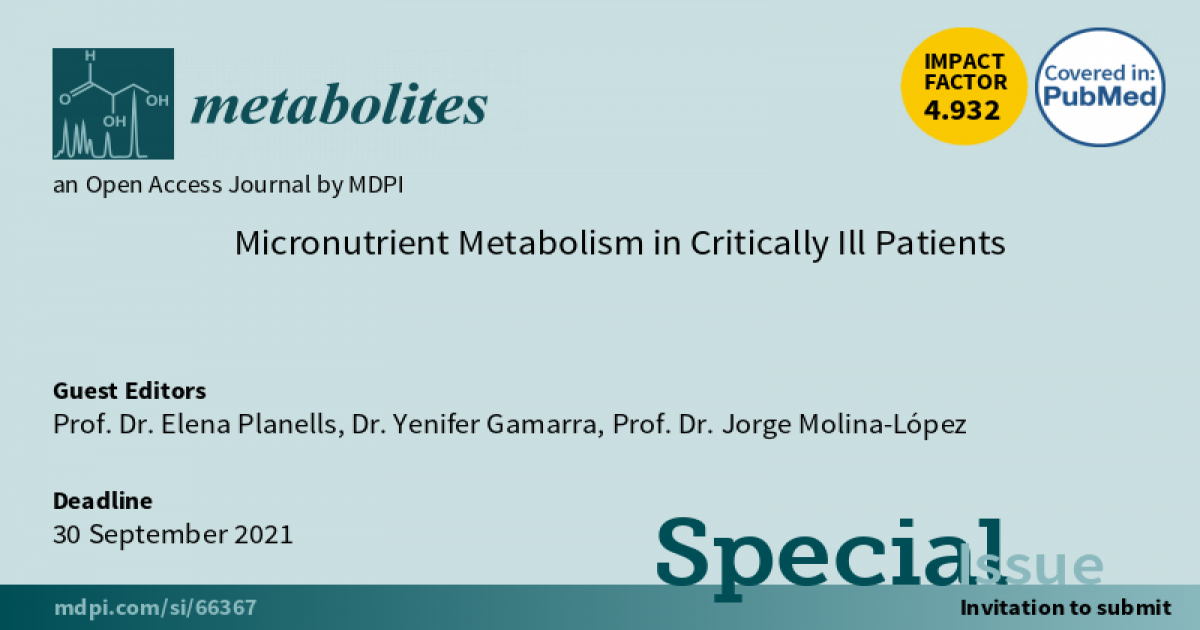Micronutrient Metabolism in Critically Ill Patients
A special issue of Metabolites (ISSN 2218-1989). This special issue belongs to the section "Endocrinology and Clinical Metabolic Research".
Deadline for manuscript submissions: closed (30 September 2021) | Viewed by 6225

Special Issue Editors
Interests: critically ill patients; micronutrients; vitamins; minerals; nutritional assessment; requirements; biomarkers; antioxidants; oxidative stress; inflammation; infection; supplementation
Special Issues, Collections and Topics in MDPI journals
Interests: critically ill patients; micronutrients; vitamins; minerals; nutritional assessment; requirements; biomarkers; antioxidants; oxidative stress; inflammation; infection; supplementation
Interests: critically ill patients; micronutrients; vitamins; minerals; nutritional assessment; requirements; biomarkers; antioxidants; oxidative stress; inflammation; infection; supplementation
Special Issue Information
Dear Colleagues,
Critically ill patients present a hypercatabolic situation and systemic inflammation that causes the accelerated depletion of micronutrients, indispensable for the balance of antioxidant systems and homeostasis. This leads to a worse evolution during their stay in the intensive care unit (ICU). The assessment of the status of micronutrients from admission to the ICU, their possible supplementation, and their monitoring during the hospital stay are key in these high-risk patients in order to optimize the therapeutic strategy and improve the results of intervention.
This Special Issue will include research articles and reviews related to critically ill patients of any etiology and implications for the behavior of micronutrients. Therefore, vitamin and mineral biomarkers associated with inflammation, infection, alteration of oxidative stress and antioxidant status, phosphocalcic metabolism, and the immune system, among others, will be welcome.
Prof. Dr. Elena Planells
Dr. Yenifer Gamarra
Prof. Dr. Jorge Molina-López
Guest Editors
Manuscript Submission Information
Manuscripts should be submitted online at www.mdpi.com by registering and logging in to this website. Once you are registered, click here to go to the submission form. Manuscripts can be submitted until the deadline. All submissions that pass pre-check are peer-reviewed. Accepted papers will be published continuously in the journal (as soon as accepted) and will be listed together on the special issue website. Research articles, review articles as well as short communications are invited. For planned papers, a title and short abstract (about 100 words) can be sent to the Editorial Office for announcement on this website.
Submitted manuscripts should not have been published previously, nor be under consideration for publication elsewhere (except conference proceedings papers). All manuscripts are thoroughly refereed through a single-blind peer-review process. A guide for authors and other relevant information for submission of manuscripts is available on the Instructions for Authors page. Metabolites is an international peer-reviewed open access monthly journal published by MDPI.
Please visit the Instructions for Authors page before submitting a manuscript. The Article Processing Charge (APC) for publication in this open access journal is 2700 CHF (Swiss Francs). Submitted papers should be well formatted and use good English. Authors may use MDPI's English editing service prior to publication or during author revisions.
Keywords
- Critically ill patients
- Micronutrients
- Vitamins
- Minerals
- Nutritional assessment
- Requirements
- Biomarkers
- Antioxidants
- Oxidative stress
- Inflammation
- Infection
- Supplementation








